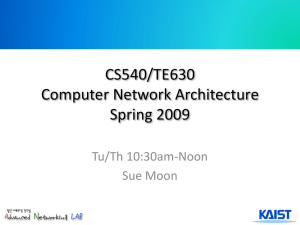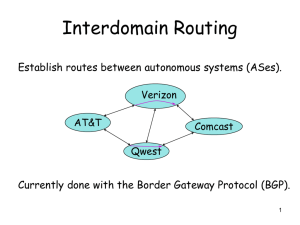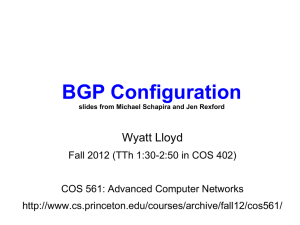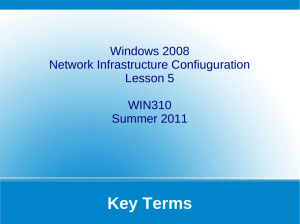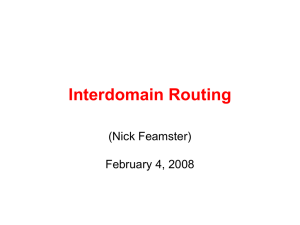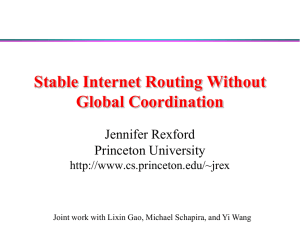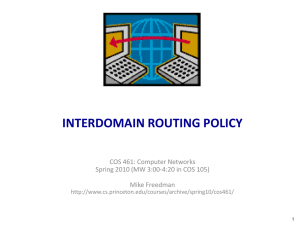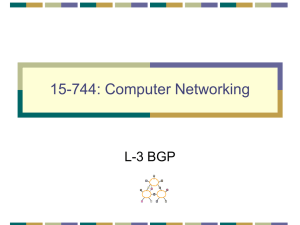Fundamentals of Computer Networks ECE 478/578
advertisement
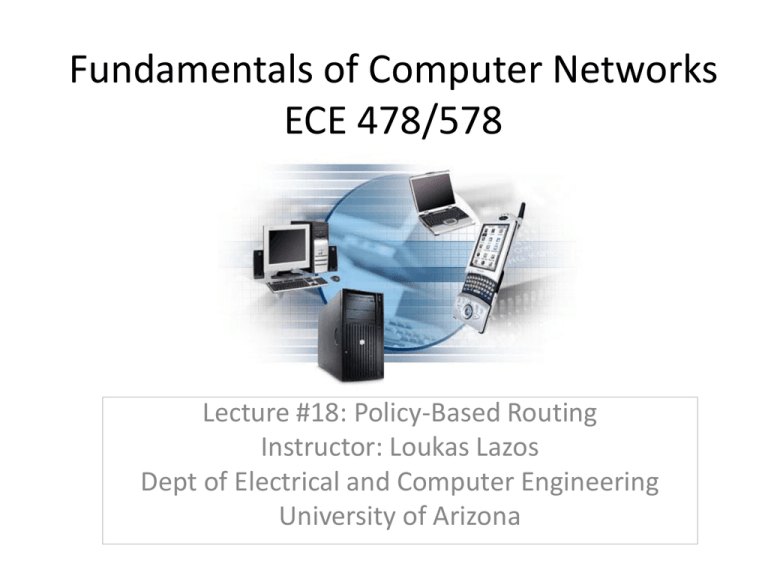
Fundamentals of Computer Networks ECE 478/578 Lecture #18: Policy-Based Routing Instructor: Loukas Lazos Dept of Electrical and Computer Engineering University of Arizona Routing on the Internet • Scale Issues – Network of IP Prefixes indicating different subnets: 150,000-200,000 so far – More than 20,000 organizations owning different “subnets” – Millions of different routes between and within subnets • Privacy Issues – Organizations may not want to reveal internal topologies • Policy Issues – No unique policy for determining the costs of links – Organizations may have preferred routes based on policies/relationships 2 Autonomous Systems • Definition: A set of routers that has a single routing policy and runs under a single technical administration. • Internet Gateway Protocol: An internal routing protocol run within the AS • Routing between ASes: External Gateway Protocol at the early stages of internet – Replaced by the Border Gateway Protocol (BGP) 3 Types of ASes • Stub AS: an AS with only a single connection to one other Ases (carries local traffic) • Multihomed AS: An AS that has connections to more than one ASes but refuses to carry transit traffic • Transit AS: An AS that has connections to more than one AS and carries both transit and local traffic 4 Drawbacks of Link-State, DV Routing • Traffic is restricted to shortest path routes • Not all nodes may assign the same metrics to links – Difficult to obtain the same global view of the network – Conflicting information may lead to routing oscillations • Topology information flooded in the entire network • High processing overhead at each node to determine appropriate routes 5 Path-Vector Routing • Key Idea: Advertise the entire path to a destination (AS) rather than the cost of the path – Based on the Distance Vector algorithm – Send cost metrics to the destination along with the entire routing path to different ASes. AS 2 AS 3 d AS 1 AS 4 AS 5 6 Advantages of Path-Vector Routing • Fast loop detection – AS can locate its own identifier in the path to a destination – Node can simply discard paths with loops – E.g. AS 5 discards route update from AS 1 AS 2 AS 3 AS 4 AS 1 AS 5 7 Flexible Policy Implementation • Each node can apply local policies – Path selection: Which path to use? – Path export: Which paths to advertise? • Examples – Node 2 may prefer the path “2, 3, 1” over “2, 1” – Node 1 may not let node 3 hear the path “1, 2” AS 2 AS 3 AS 1 8 Border Gateway Protocol (BGP) • Interdomain routing protocol for the Internet – Prefix-based path-vector protocol – Policy-based routing based on AS paths – Evolved during the past 15 years AS 1 AS 2 BGP session – Establish a TCP connection on port 179 – Exchange information on all known active routes – Exchange incremental updates 9 Storing and Learning Routes • BGP router stores multiple routes toward a destination – Policies are applied for the selection of the “best” route – …and which routes shall be advertised • Incremental updates – Announcement • New active routes toward destinations are updated by sending BGP updates – Withdrawal • If a route is no longer active, a withdrawal notification is sent to all neighbors 10 Routing in BGP • Destination prefix based • Includes route attributes such as next hop and AS path 192.168.0.5 AS 1 AS 3 AS 2 128.122.56.0/16 116.128.1.1 D: 128.122.56.0/16 AS_path = AS 1 Next _Hop = 192.168.0.5 12.127.2.1 101.108.2.2 D: 128.122.56.0/16 AS_path = AS 2 AS 1 Next _Hop = 12.127.2.1 11 BGP Attributes • AS Path – Sequence of ASes that a route has traversed – Used for detecting loops and applying policies • Next Hop – Next hop to reach a network • Local Preference – Used to influence selection of paths – Path with highest local preference is selected • Multi-Exit Discriminator (MED) – Use to influence exit (entry) point when multiple BGP routers exist in an AS 12 BGP Path Selection • Follow a minimum hop approach – Shortest AS path – Arbitrary tie break • Example – AS 2 routes to AS 6 through AS 3 • BGP is mainly policy-based routing 192.168.0.5 AS 1 AS 3 AS 2 116.128.1.1 D: 128.122.56.0/16 AS_path = AS 1 AS 4 AS 6 Next _Hop = 192.168.0.5 12.127.2.1 101.108.2.2 D: 128.122.56.0/16 AS_path = AS 3 AS 6 Next _Hop = 101.108.2.2 13 BGP Policy • Import policy – Filter unwanted routes from neighbor • E.g. prefix that your customer doesn’t own – Manipulate attributes to influence path selection • E.g., assign local preference to favored routes • Export policy – Filter routes you don’t want to tell your neighbor • E.g., don’t tell a peer a route learned from other peer – Manipulate attributes to control what they see • E.g., make a path look artificially longer than it is 14 Import Policy – Local Preference • Favor one path over another – Used to override shortest AS path principle – Example: prefer a customer AS Local pref =100 AS 2 T-mobile AS 3 AS 4 AS 1 Local pref = 200 AS 5 Sprint 15 Filtering • Import Policy – Discard certain advertised paths – Recognize network or AS based on prefix • Discard routes that contain large ISPs (may induce longer delays) • Discard pre-fixes if not owned • Export Policy – – – – Limit propagation of routing information Don’t announce routes from one peer to another Don’t advertise routes containing untrusted ASes Manipulate attributes to influence the way that other ASes perceive routes 16 BGP Policy Configuration • Routing policy languages are vendor-specific – Not part of the BGP protocol specification – Different languages for Cisco, Juniper, etc. • Still, all languages have some key features – Policy as a list of clauses – Each clause matches on route attributes – … and either discards or modifies the matching routes • Configuration done by human operators – Implementing the policies of their AS – Business relationships, traffic engineering, security, … 17 Other Considerations • AS_path can be misleading in terms of delay and # of hops AS 1 AS 2 AS 4 AS 3 18 Treating Multiple Routers within an AS • BGP routing info is disseminated within an AS using iBGP eBGP iBGP AS 1 19 Combination of eBGP with iBGP E A B C D 20 Hot-potato (deflection) Routing • Incentive – Minimize required storage, probability of buffer overflow • Key idea: Get rid of packets as soon as possible – Packets may not necessarily follow optimal paths (deflect packets wherever possible) – E.g., if two packets must go out on the same link, deflect one of them to another at random Local pref = 90 AS 1 AS 2 AS 3 Local pref = 200 AS 4 AS 5 21
